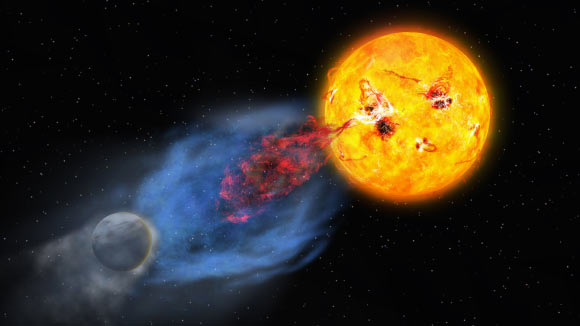Down here on Earth we don’t usually notice, but the Sun is frequently ejecting huge masses of plasma into space. These are called coronal mass ejections (CMEs). Using the NASA/ESA Hubble Space Telescope and ground-based telescopes in Japan and Korea, astronomers have now detected signatures of a multi-temperature CME from EK Draconis, a young G-type main-sequence star located 112 light-years away in the northern constellation of Draco.
“Scientists believe that when the Sun and the Earth were young, the Sun was so active that CMEs may have affected the emergence and evolution of life on the Earth,” said Kyoto University astronomer Kosuke Namekata and colleagues.
“In fact, previous studies have revealed that young Sun-like stars frequently produce powerful flares that far exceed the largest solar flares in modern history.”
“Huge CMEs from the early Sun may have severely impacted the early environments of Earth, Mars, and Venus.”
“However, to what extent explosions on these young stars exhibit solar-like CMEs remains unclear.”
“In recent years, the cool plasma of CMEs has been detected by optical observations on the ground.”
“However, the high velocity and expected frequent occurrence of strong CMEs in the past have remained elusive.”
In their study, the authors focused on EK Draconis, a young solar analogue with an estimated age of 50-125 million years.
The effective temperature, radius and mass of the star, which is also known as EK Dra and HD 129333, make it one of the best proxies for the infant Sun.
“Hubble observed far-ultraviolet emission lines sensitive to hot plasma, while the three ground-based telescopes simultaneously observed the hydrogen-alpha line, which traces cooler gases,” the astronomers said.
“These simultaneous, multi-wavelength spectroscopic observations allowed us to capture both the hot and cool components of the ejection in real time.”
These observations provide the first evidence of a multi-temperature CME from EK Draconis.
“We found that hot plasma of 100,000 K was ejected at 300 to 550 km per second, followed about ten minutes later by a cooler gas of about 10,000 K ejected at 70 km per second,” the astronomers said.
“The hot plasma carried much greater energy than cool plasma, suggesting that frequent strong CMEs in the past could drive strong shocks and energetic particles capable of eroding or chemically altering early planetary atmospheres.”
“Theoretical and experimental studies support the critical role that strong CMEs and energetic particles can play in initiating biomolecules and greenhouse gases, which are essential for the emergence and maintenance of life on an early planet.”
“Therefore, this discovery has major implications for understanding planetary habitability and the conditions under which life emerged on Earth, and possibly elsewhere.”
The team’s paper was published in the journal Nature Astronomy.
_____
K. Namekata et al. Discovery of multi-temperature coronal mass ejection signatures from a young solar analogue. Nat Astron, published online October 27, 2025; doi: 10.1038/s41550-025-02691-8








